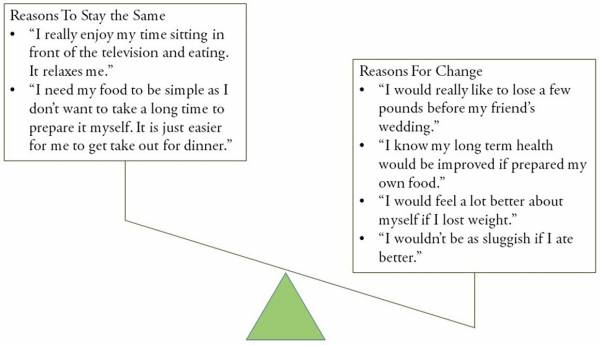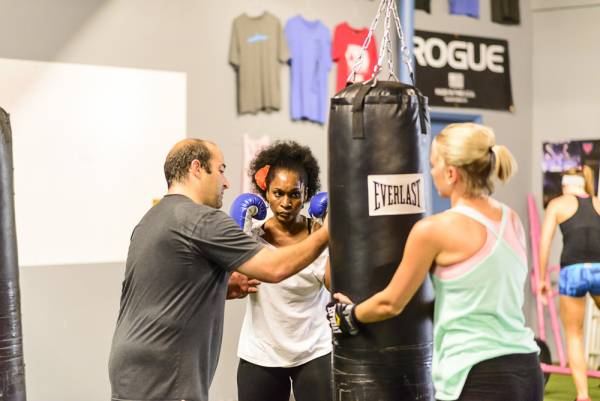There is a powerful technique to help people make positive health changes by reframing how they see their goals. These motivational interviewing techniques can provide a simple and effective way for people to make big life changes.
Resolving Ambivalence
Motivational Interviewing was co-founded by Dr. William R. Miller and Dr. Stephen Rollnick.1 The technique was originally used to help people stop high-risk behaviors such as substance abuse. One main principle is that people are often ambivalent about changing and this ambivalence needs to be addressed for people to be able to change.
On one hand a person’s current behavior has some rewards, but on the other hand a change in behavior is also appealing. Thus, there is a constant back and forth about making changes. Motivational Interviewing attempts to tip the balance of this ambivalence into the change direction.
Let’s take an example of a person thinking about a change in diet. A decisional balance exercise (as pictured below) can help people make better decisions. Basically, a person is asked to write down all the reasons for change and all the reasons to stay the same. It is done in an honest way, so that all the reasons to stay the same are realistically expressed.

The motivation comes from seeing both sides of the story and seeing what the barriers to change might be. As a person realizes the reasons for his or her current behavior, he or she can also see why it has been so difficult to change. This realization takes away some of the pressure, as there is often guilt associated with unhealthy behaviors. It also helps people be more realistic when they are in the midst of change and it becomes difficult.
Advice for Athletes
Completing a decisional balance exercise like the picture above can be very helpful. Ambivalence will rise and change over time, so it is a good idea to put your picture or outline somewhere where you can see it. Use it to find a key reason why you want to make a change.
One of the most important ideas is to know that change is difficult and you should not get too frustrated if you are not perfect in aiming for your goals. It is progress that you want and not perfection. Changes accumulate over time, so each small change adds up and eventually multiplies. A small change today has many dividends later.
Advice for Coaches
There are research findings indicating that people are more likely to stick to their goals if they set them themselves. Thus, your job is to help them discover their goals, as well as to help them complete the decisional balance in an unbiased manner.
In training future psychologists, I have seen many beginners want to jump right into the reasons for change. As a coach, your job is to completely explore the difficulties that a person will have making a change. One question you could ask is, “What barriers could get in the way of you making that change?” The more you are realistic with people on the difficulties they might face, the more they will have trust in your ability to work with them. Rarely, do coaches ask clients about the good things about not exercising or not making healthy change.
Once goals are set, then frequently remind your clients about why they are doing what they set out to do. For example, “You have been doing really great at coming in three days a week. I know that was important to you before your friend’s wedding.”

Short-Term Benefits Versus Long-Term Consequences
One of the biggest barriers to change is that we often can see the short-term benefits to our current behavior, but not the consequences. It feels great to eat take-out from a not-so-healthy restaurant or to sleep in and not exercise. It is more difficult to see the long-term effects of this behavior. If we don’t feel the consequences right away, it takes a lot of willpower or thought process to make change.
We don’t touch hot stoves because we learned at a young age the immediate consequences. However, we don’t see the consequences of healthy (or unhealthy) behaviors for quite a bit after we do them. Thus, people need to be constantly aware of the long-term effects, and not just bad ones. People need frequent reminders of why they are doing what they are doing even if they don’t see immediate rewards. For example, “It is great you have been doing your deadlifts every week, that will come in really handy when your grandchildren come to visit.”
The Million-Dollar Question
Many people don’t feel like they have the ability to change. “I have been un-athletic my whole life, I don’t know whether I can get in shape.” One potential way to get around this issue is to ask the million dollar question (I attribute this idea to Linda and Mark Sobell, great researchers in motivational interviewing).2,3
The million dollar question is framed like this: “If you had to (insert behavior here) for X amount of time to win a million dollars, could you do it?” This question shows people that if the reward were enough, they could complete the specified behavior.

Normalizing
One of the biggest commonalities with change is that it is difficult, but people feel that it should be easy. Knowing that making a change is difficult can take some of the pressure off the person making the change. A coach who lets clients know that many people have had this difficulty normalizes the experience. It makes people feel less unusual and more forgiving of their complications.
Motivation Is Fluctuating, But Also Modifiable
A person’s motivation to change moves daily. Some days we are ready and eager to tackle life’s challenges. But the days when we are not so ready are the most important. Use these days as lessons in what works and what doesn’t work to help you become more motivated. Some other ideas include:
- Rewriting your decisional balance – If looking at (or rewriting) your decisional balance helps you become motivated, then you’ve found a good secret.
- Acting “as if” – One of the most successful strategies is to act as if you would if you were to achieve your goal. Sometimes people want the motivation first, but behavior is a powerful motivator. Do the healthy behavior and more motivation will come.
- Failure as a learning experience – Use failures as learning experiences. Failures are not the end of the world, rather they are a great opportunity to learn something about yourself. If you do not do well, then try to figure out what happened. Did you get enough sleep? Did stress affect your motivation? If you fail, try to use that information to help you do better the next time.
- Future orientation – Sometimes putting yourself in a future perspective can help. This can be done by asking yourself, “What would happen five years from now if I do not change?”
The Take Home on Motivational Interviewing
Motivational Interviewing is a powerful strategies to help people see past the short-term benefits of unhealthy behavior and see how future benefits will be even greater. It is a helpful technique for both coaches and athletes.
References:
1. Miller, W. R., & Rollnick, S. (2002). Motivational interviewing: Preparing people to change (2nd edition). New York: Guilford.
2. Montgomery, Martha, Linda C. Sobell, Mark. B. Sobell, and Craig. D. Marker. 2009. “Does Source of Media Recruitment of Problem Drinkers Matter?” Alcoholism-Clinical and Experimental Research, 33:44.
3. Sobell, L. C., & Sobell, M. B. (2003). “Using motivational interviewing techniques to talk with clients about their alcohol use.” Cognitive and Behavioral Practice, 10, 214-221.
Photo 1 courtesy of Shutterstock.
Photo 3 courtesy of CrossFit Empirical.






